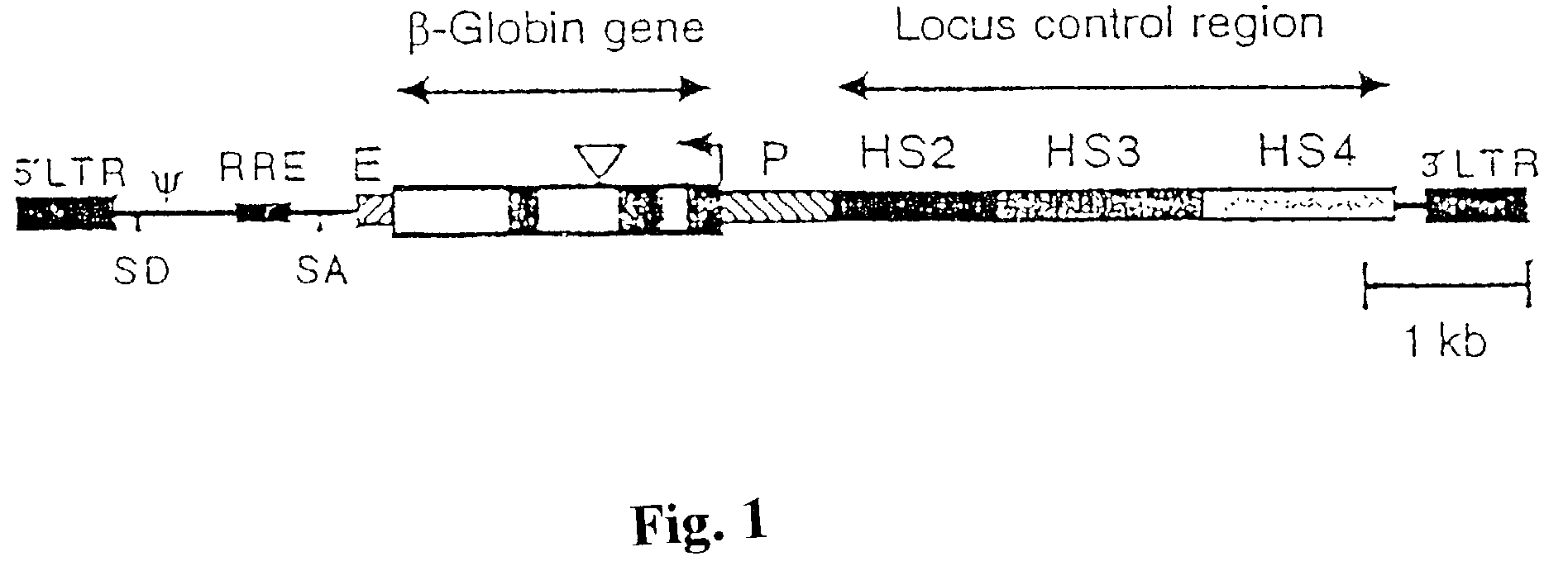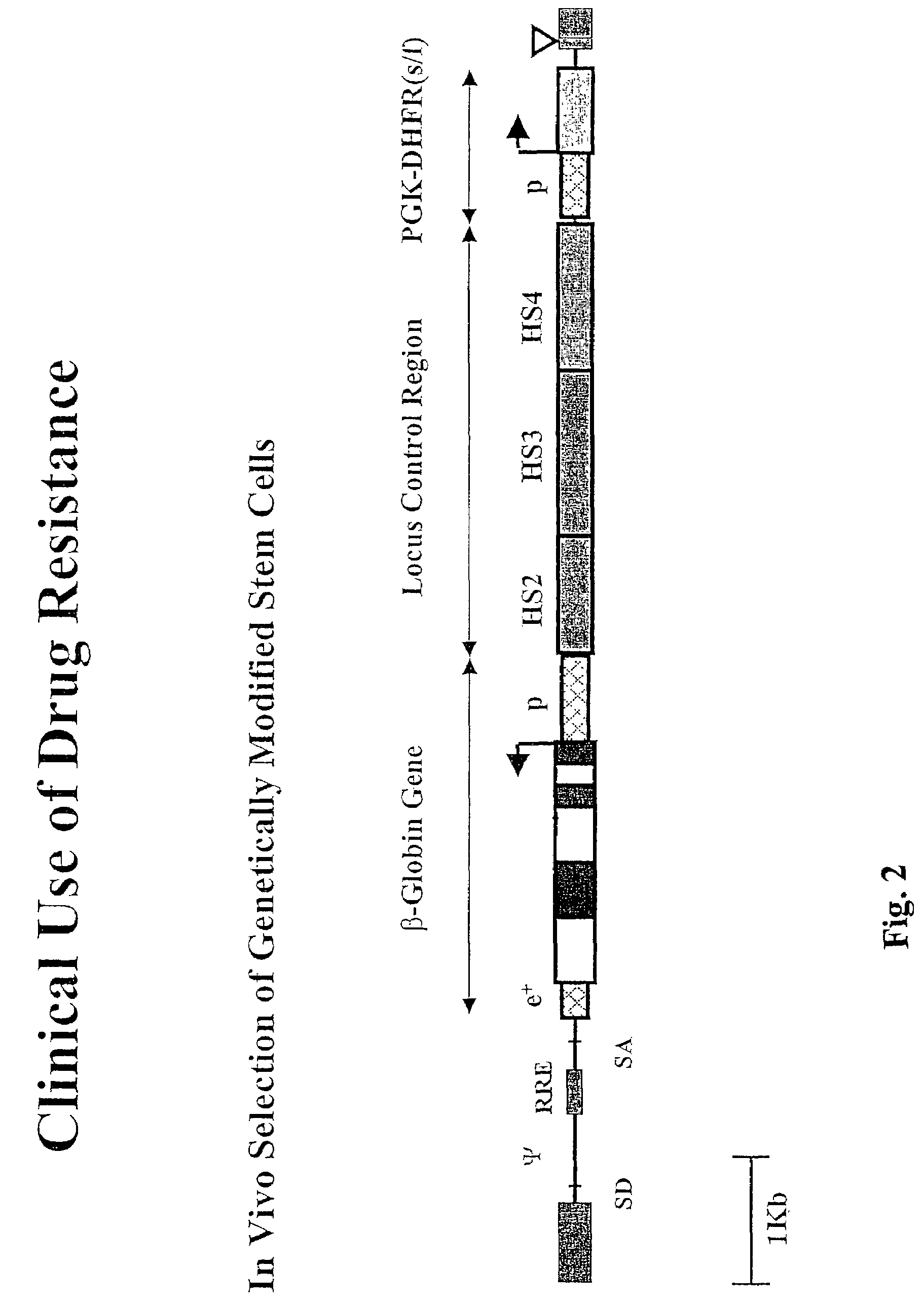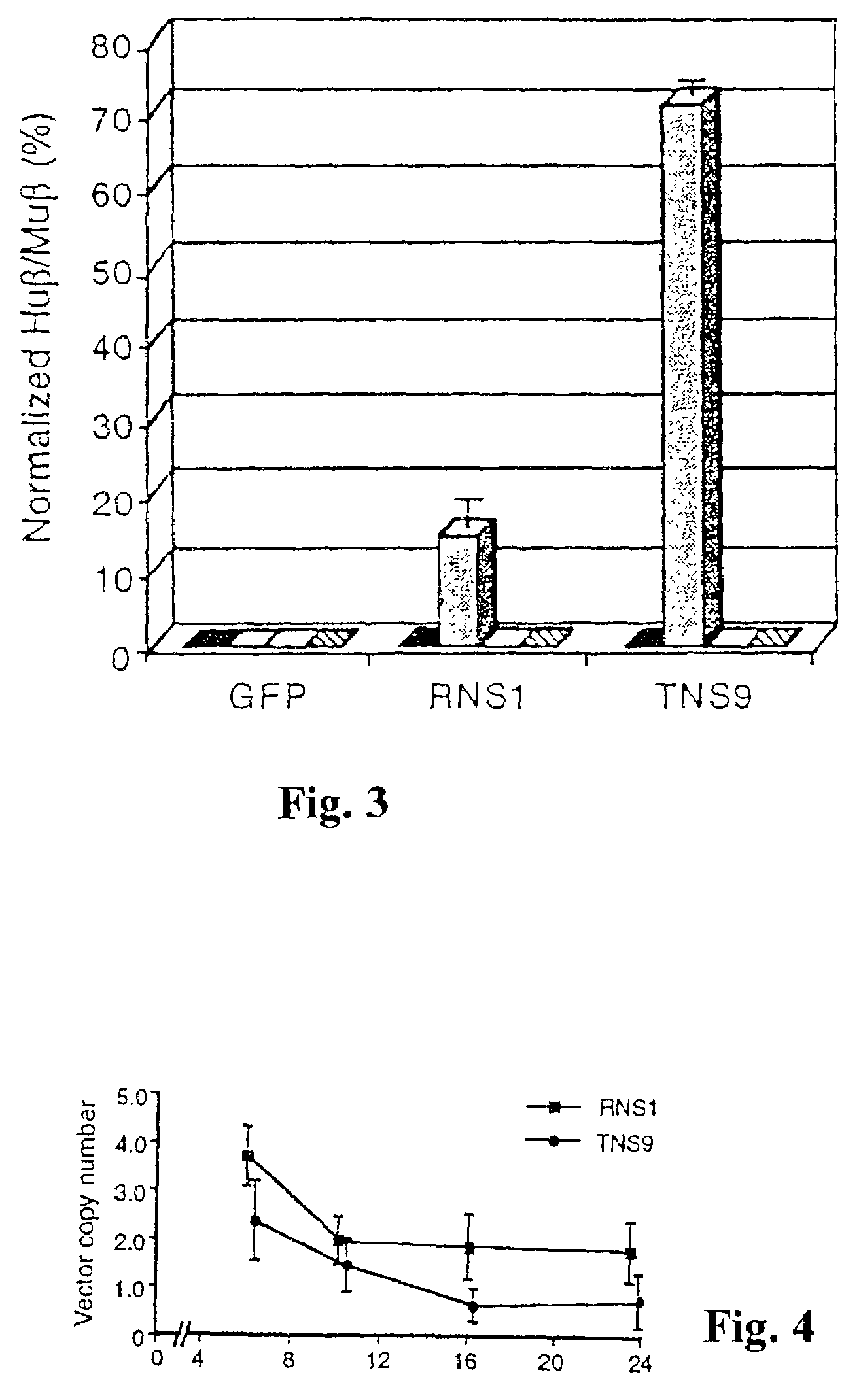Vector encoding human globin gene and use thereof in treatment of hemoglobinopathies
a technology of human globin and gene, applied in the field of human globin gene, can solve the problems of carrying a lethal risk and not being available to the majority of patients
- Summary
- Abstract
- Description
- Claims
- Application Information
AI Technical Summary
Benefits of technology
Problems solved by technology
Method used
Image
Examples
example 1
[0030]To produce vector TNS9, the human β-globin gene was subcloned from Mβ6L (Sadelain et al. Proc. Nat'l Acad. Sci. (USA)92: 6728-6732 (1995)) into lentiviral vector pHR'LacZ (Zuffery et al., Nature 15: 871-875 (1997)) replacing the CMV-LacZ sequence. pHR'eGFP was constructed by replacing LacZ with the eGFP sequence (Clontech). Viral stocks were generated by triple transfection of the recombinant vectors pCMVΔR8.9 (Zuffrey et al.) and pMD.G in 293T cells as previously described in Dull, et al., J. Virol. 72: 8463-8471 (1998). The pseudotyped virions were concentrated by ultracentrifugation resuspended and titrated as described in Gallardo et al., Blood 90: 952-957 (1997). For comparison, RSN1 was used which has a similar structure, except that the LCR contains only the core portion of HS2, HS3 and HS4. Northern blot analysis showed full length RNA transcripts, indicating that the recombinant lentiviral genomoes are stable. Southern blot analysis on genomic DNA from transduced cell...
example 2
[0031]To investigate the tissue specificity, stage specificity and expression level of the vector-encoded human B-globin gene, we transduced RNS1 and TNS9 into MEL cells, lymphoid Jurkat cells and myeloid HL-60 cells. Cell-free viral supernatant was used to infect C88 MEL cells in the presence of polybrene (8 μg ml−1). Transduced MEL cells were subcloned by limiting dilution, and screened by PCR for transduction30 using primers that anneal in the human β-globin promoter sequence (βPS, 5′-GTCTAAGTGATGACAGCCGTACCTG-3′, Seq ID No.: 1) and in HS2 (C2A, 5′-TCAGCCTAGAGT GATGACTCC TATCTG-3′, Seq ID No.: 2). Vector copy number and integration site analysis was determined by Southern blot analysis9. Transduced MEL cells were induced to maturation by 5-day culture in 5 mM N,N′-hexamethylene bisacetamide (HMBA, Sigma).
[0032]To induce β-globin transcription, transduced MEL cell pools were differentiated using hexamethylene bisacetamide HMBA). Human β-globin (βA) and mouse β-globin transcripts w...
example 3
[0033]Quantification of Human β-globin mRNA
[0034]Total RNA was extracted from MEL, Jurkat and HL-60 cells, or mouse spleen and blood using TRIzol. Quantitative primer extension assays were done using the Primer Extension System-AMV Reverse Transcriptase kit (Promega) with [32P] dATP end-labelled primers specific for retroviral-derived human β-globin (5′-CAGTAACGGCAGACTTCTCCTC-3′, Seq ID No.: 3) and mouse β-globin (5′-TGATGTCTGTTTCTGGGGTT GTG-3′, Seq ID No.: 4), with predicted extension products of 90 bp and 53 bp, respectively. The probes yield products of identical length for βmaj, βmin, βs and βt. Primers were annealed to 4 μg of RNA and reactions were run according to manufacturer's protocols. Radioactive bands were quantitated by phosphorimager analysis (BioRad). RNA isolated from A85.68 mice20 was used as positive control. After correction for primer labelling, the human to mouse RNA signal was 29±1% per gene copy in repeated experiments (n>8), in agreement with previous findin...
PUM
| Property | Measurement | Unit |
|---|---|---|
| resistance | aaaaa | aaaaa |
| β-globin | aaaaa | aaaaa |
| γ | aaaaa | aaaaa |
Abstract
Description
Claims
Application Information
 Login to View More
Login to View More - R&D
- Intellectual Property
- Life Sciences
- Materials
- Tech Scout
- Unparalleled Data Quality
- Higher Quality Content
- 60% Fewer Hallucinations
Browse by: Latest US Patents, China's latest patents, Technical Efficacy Thesaurus, Application Domain, Technology Topic, Popular Technical Reports.
© 2025 PatSnap. All rights reserved.Legal|Privacy policy|Modern Slavery Act Transparency Statement|Sitemap|About US| Contact US: help@patsnap.com



